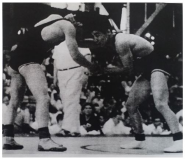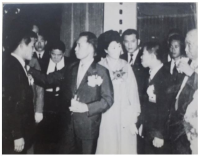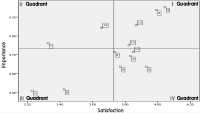PURPOSE This study aimed to identify the lower limb muscle activity based on direction prediction presence or absence and gender during side cutting in healthy college students. METHODS The study participants included 14 healthy males and females (8 males; 6 females). All participants ran at full speed for a distance of 12m, and side-cutting was carried out at 45 degrees in a randomly indicated direction and in a fixed direction. Simultaneously, data regarding vastus medialis, vastus lateralis, semitendinosus, and biceps femoris muscle activity of the dominant leg were collected using an electromyography sensor, and data regarding vertical acceleration were collected using an inertial sensor attached to the pelvis. A sync webcam was used for obtaining the initial contact of side cutting and the stance period time. During the 10 milliseconds (pre-activation) prior to the initial contact and 50% of the stance phase (loading phase), vastus medialis, vastus lateralis, semitendinosus, and biceps femoris average muscle activity and hamstring to quadriceps ratio included as variables. RESULTS During the pre-activation and loading phase, the vastus medialis muscle activity of the male group was higher in the unexpected condition than in the expected condition. Furthermore, hamstring to quadriceps ratio was confirmed to be lower under unexpected condition compared to under expected condition during on loading phase. CONCLUSIONS The study results suggest that the risk of anterior cruciate ligament injury may increase with side cutting under unpredictable conditions. It is expected to provide useful information for identifying factors related to knee injury in the general population.
PURPOSE This study aimed to apply a capacity building program to sport life skill leaders and to provide cases of this process. METHODS The study participants included four leaders (male=2, female= 2, Mage=37.5) who were managing a sport life skills program at a university. They participated in a capacity building program, which consisted of (a) understanding (leader seminar), (b) application (managing the sport life skills program), and (c) evaluation (leader’s self-reflection), which were conducted in eight sessions. Four leaders conducted self-evaluations using program quality assessment (PQA) during every session, and quantitative and qualitative data were collected. Qualitative data were derived using a cross-case analysis, and quantitative data were used for calculating the effect size after performing the paired t-test. RESULTS Analyzing the reported cases of sport life skill leaders, the use value of the capacity building program was identified. Furthermore, the cases reported by the four leaders enabled observation of how the leader’s capabilities were strengthened. In the paired t-test, the effect size of physical and psychological safety, appropriate structure, supportive relationship, opportunities to belong, support for efficacy mattering, opportunities for life skill building, excluding integration of family, school, and community effort, were all significant. All effect sizes were found to have “very large effects.” CONCLUSIONS The capacity building program played a positive role in strengthening the leaders’ life skill coaching capabilities. These findings have practical implications—chiefly, it is important to strengthen leaders’ or coaches’ capabilities in order to foster life skill development and transfer of student-athletes.
PURPOSE The purpose of this study was to investigate the effects of 8-week aerobic exercise and polyphenol intake on body composition, cardiovascular response, vascular endothelial function, and physical fitness at rest and during exercise in prehypertensive men. METHODS The study included twenty-eight males in their 20-30 years of age with prehypertension. Participants in the aerobic exercise + polyphenol intake group (EX + PP; n = 14) performed aerobic exercise three sessions/week, 30 min/session, at 65% of the heart rate reserve, and consumed polyphenol (grape seed extract 300 mg) for 8 weeks. Participants in the aerobic exercise + placebo intake group (EX + PL; n = 14) performed the same aerobic exercise; however, they consumed placebo instead of polyphenol. All independent variables were measured at pre-test and post-test, and the data were analyzed. RESULTS The main results of the study were as follows: 1) SBP and MAP at rest decreased significantly in EX + PP, while MAP decreased significantly in EX + PL group. 2) In the EX + PP group, CO increased significantly, whereas DBP, MAP, and TPR decreased significantly during the hand grip exercise. In contrast, CO decreased significantly, while DBP and TPR increased significantly in the EX + PL group during the hand grip exercise. 3) Regarding vascular endothelial function, % FMD increased significantly in EX + PP group. 4) Sit-up increased significantly in both EX + PP and EX + PL groups; however, sit-and-reach in EX + PP group was significantly higher than that in EX + PL group at post-test. CONCLUSIONS The findings of this study showed that the 8-week aerobic exercise would have positive effects on body composition, cardiovascular response, and physical fitness at rest and during exercise in hypertensive men. Additionally, polyphenol intake would contribute more towards reduction of blood pressure at rest and during exercise and improvement of vascular endothelial function.
PURPOSE This study aimed to apply a team-building program for preparing the national archery team for competition in the Olympics. METHODS To achieve the purpose of this study, six national archers (three men and three women) were included. The team-building program was applied for a total 6 sessions (one session per week). Group cohesion and efficacy were measured three times before, after, and at a later application of the program. The collected data were analyzed with the Friedman and Wilcoxon signed-rank tests, which are nonparametric statistical techniques for data analysis. In addition, an in-depth interview for qualitative data was conducted for each archer to explore the effects and changes resulting from participation in the program. RESULTS The results of the study are as follows: first, the levels of team cohesion and efficacy in the national archery team increased after the implementation of the program compared to those in the pre-implementation state. Furthermore, high levels of team cohesion and efficacy were maintained at the follow-up measurement. Second, the archers recognized that closeness and faith in one another increased more between team members. Furthermore, there were positive changes in team communication, atmosphere, cohesion, and efficacy during team matches. CONCLUSIONS The team-building program applied in this study was found to have a positive effect on various factors related to team cohesion, such as team communication and team atmosphere. Therefore, future studies should consider developing a team-building program that can contribute to improving team sport performance for different sports and the effects of the program should be examined using various methods.
PURPOSE The purpose of this study was to validate the Korean version of Coaching Life Skills in Sport Questionnaire (KCLSS-Q). METHODS Substantive, structural, and external stages were undertaken to address the purpose of this study. At the substantive stage, the scale was translated by discussing with an expert panel and testing item clarity. Ten coaches (9 males, Mage=33.80, SD=4.21) participated in the item clarity test. At the structural stage, descriptive statistics, exploratory factor analysis (EFA), and confirmatory factor analysis (CFA) were conducted. A total of 249 (214 male, Mage=34.18, SD=6.82) and 232 coaches (186 male, Mage=34.26, SD=7.69) participated in the EFA and CFA, respectively. At the external stage, correlation analysis using other scales (emotional intelligence in sport coaching, EISSC) was conducted to examine concurrent validation. A total of 130 copies of the CFA data were randomly extracted and used for this stage. RESULTS For the EFA, the scale extracted five factors with 27 items. In the CFA, however, five factors with 26 items were identified as an appropriate structure. Finally, the relationships of all sub-factors between KCLSS-Q and EISSC were statistically significant in the correlation analysis. CONCLUSIONS KCLSS-Q should reasonably consists of nine items on structuring and facilitating a positive sport climate, five on understanding life skills, four on practicing life skills, five on understanding life skills transfer, and three on practicing life skills transfer. KCLSS-Q can be used as a valid measure to evaluate the coaching life skills of Korean coaches.
PURPOSE This study investigated the associations between physical fitness and fall efficacy with thigh circumference in elderly women with osteopenia/osteoporosis. METHODS A total of 166 female participants aged 76.3±5.0 years with –1.0≥T-score of femur neck bone mineral density were voluntarily recruited from local community centers. The participants were classified as low 25%, middle 50%, and high 25% groups based on their thigh circumference. Physical fitness measurements, including strength, flexibility, aerobic endurance, and balance were measured with a standardized protocol. The Korean version of the fall efficacy scale (K-FES) was used to assess fall efficacy. Logistic regression analysis was used to estimate odd ratio (OR) of poor physical fitness and low fall efficacy according to thigh circumference levels. RESULTS In terms of physical fitness, the middle 50% group (OR=0.430, 95% CI=0.194-0.953) and high 25% group (OR=0.129, 95% CI=0.049-0.343) had significantly higher linear trend for poor physical fitness compared to the low 25% group (reference), (p<0.001). In fall efficacy, the middle 50% group (OR=0.279, 95% CI=0.119-0.656) and high 25% group (OR=0.100, 95% CI=0.036-0.275) had significantly higher linear trend for low fall efficacy compared to the low 25% group (reference) (p<0.001). CONCLUSIONS The current findings suggest that maintaining high thigh circumference via regular physical activity and diet may contribute to attenuation of decreased risk for poor physical fitness and low fall efficacy in elderly women with osteopenia/osteoporosis.
Purpose This research aims to find out factors affecting policy at the agenda setting phrase. In order to analyze, Multiple Streams Framework(MSF) was adopted. Based on the frame, policy problem stream, policy alternative stream, political stream, window of policy change, and policy entrepreneur were applied for analytical framework. Methods The research conducted qualitative research with triangulation. Data were collected by in-depth interview and literature review including newspaper and previous researches. Content analysis was done for deriving factors. Then categorization and itemization were conducted. Results For the result, factors derived from the study were not different from factions mentioning at MSF. For policy problem stream perspective, this study draw International Sports Event Result, Hosting International Sports Event, Elite Sports Athletic Recruiting, Athletic and Sports Category Supporting System, Student Study Right/Student Human Right/Sports Academy, Policy Reality, Sport Expert/Institute Capability, Perception of Elite Sport Origin. factors. In the case of Policy Alternative Stream, This study finds Sports Related Administrative Organization Restructure, Supporting Policy of Elite Athletic Promoting Restructure, Parent Policy of Elite Athletic Promoting Policy, Parent Institution of Elite Athletic Promoting Law, Incentive Institution for Elite Athletic, Supporting Institution for Elite Athletic, Value of Policy Community for Sports Category Feature, Value of Policy Community for Sports Category Fairness, Budget, International Sports Event Hosting Policy factors. Lastly, in the political perspective, this study figures out Elite Sports for Nation Integration, Elite Sports for Enhancing National Prestige (North and South Replacement), Elite Sports for Inter Korean Reconciliation and Cooperation, Sports Related Administrative Organization Restructure Following Regime Change, Parent Policy Change of Elite Sports Following Regime Change factors. Conclusions The research has academic implication for generating elite sport policy agenda setting model as well as practical implication for urging effective participation of various practitioners concerning elite sport.
Purpose The purpose of this study was to examine the effects of 16 weeks’ combined exercise training on insulin resistance, inflammatory markers, oxidative stress, leukocyte telomere length, body composition, and daily living fitness in elderly women with type 2 diabetes mellitus (DM). Methods Twenty-eight participants were randomly assigned into one of two groups, i.e., exercise training group (EX: n=14) and control group (CON: n=14). Subjects in EX participated in 3 sessions of 60 min-combined exercise for 16 weeks, whereas subjects in CON were asked to maintain their normal life pattern during the same period. The variables regarding insulin resistance, inflammatory markers, oxidative stress, leukocyte telomere length, body composition, and daily living fitness were measured and compared between two groups as well as between pre-post test utilizing a repeated two-way ANOVA. Results Main results were as follows: 1) Fasting plasma insulin and HOMA-IR tended to decrease in EX, whereas increased significantly in CON. 2) IL-6, TNF-α, hs-CRP decreased in EX, but the changes were not statistically significant. 3) MDA increased significantly and GPx decreased significantly in both EX and CON. 4) Leukocyte telomere length increased significantly in EX. 5) Fat-free mass increased in EX, whereas fat mass and percent body fat decreased significantly in EX. 6) Arm curl, chair stand, sit & reach, tandem test, 10m walking speed, and up & go improved significantly in EX. Conclusion It was concluded that the combined exercise for 16 weeks had a positive effect on improving insulin resistance, increasing leukocyte telomere length, as well as enhancing body composition and daily living fitness in elderly women with type 2 diabetes.

[Purpose] The purpose of this study was to investigate the process of Jang Changsun’s winning gold medal in the 1966 Toledo World Amateur Wrestling Championship and its meaning. [Methods] Jang Changsun and Katsumura Yasuo who had competed with Jang Changsun for the gold medal were selected as participants, a player and an executive who had participated in the Championship were selected as informants. Data had been collected by in-depth interview were analyzed firstly by using the Patton(1991)’s data analysis method, and the following conclusions were obtained by comparing with preceding studies, press releases, reports etc. [Results] Jang Changsun won a gold medal through the three stages of desperate struggles. The first struggle was to loose weight. Jang Changsun lost three times more weight than other players through fasting treatment, intensive training and dehydration in order to secure an advantageous position in the competition. His second struggle was the sparring itself. He made his mind to win gold medal 2 years before the Championship and started to strengthen his physical fitness and polish up his techniques to fight with strong players from powerful nation of wrestling. He finished the sparring by winning 4 games and tieing 2 games resulting in the same deduction points with Katsumura. It was inevitable for him to fight desperately to lose weight again to get gold medal. He eventually won the gold medal by losing his weight until he fainted because of injuries and serious dehydration. [Conclusion] The first gold medalist Jang Changsun contributed a lot to development of Korean sports by offering chance to consider significance of improving elite player’s exercising environment, scientific coaching, gaining self-confidence to win medal, and realizing the importance of sports informations.



Purpose The purpose of this study is to grasp consumers' perception of badminton racket brand image using MDS and ISA. Methods To do this, we conducted questionnaires on those who participated in badminton and had experience of participating for 6 months or more in Seoul and Gyeonggi province from April 12 to 28, 2017, selected and analyzed a total of 313 copies as valid samples of this study. Results The results of study are as follows. First, as a result of MDS analysis, it showed that only the price of brand image attributes were in order of Trion > Joobong > Lining > Victor > Yonex, and the other attributes(Design, Functionality, Quality, Awareness, Advertising image, Event, Color, Popularity, Sophistication, Originality, Trust, Service) were in order of Yonex > Victor > Lining > Joobong > Trion. Second, as a result of ISA analysis, in I quadrant, Yonex showed functionality, quality, sophistication, and trust and Trion showed price, design, functionality and quality, Victor showed price, design, functionality, quality, color, sophistication, trust, service, and Joobong showed price, functionality, quality, and trust in this area. In quadrant Ⅱ as concentrated area, Yonex showed price and service, Trion showed color, trust, service, Victor showed price, Lining showed trust and service, and Joobong showed service in this area. In quadrant Ⅲ as low rank, Yonex showed advertising image, event, Trion showed awareness, advertising image, event, popularity, sophistication, originality, Victor showed advertising image, event, popularity, originality, Lining showed awareness, advertising image, event, popularity, originality, and Joobong showed design, advertising image, color, popularity, sophistication in this area. In quadrant IV as excess avoidance, Yonex showed design, awareness, color, popularity, originality, Victor showed awareness, Joobong showed awareness, event, originality in this area.







